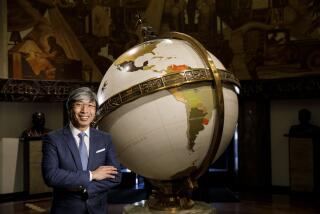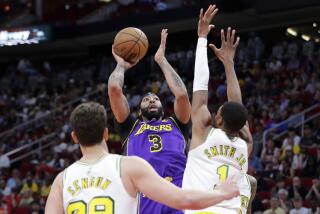Times Publisher Apologizes for Staples Center Deal
Los Angeles Times Publisher Kathryn M. Downing on Wednesday apologized for entering into an agreement to share the profit from a special issue of the Times Magazine with Staples Center, the new downtown sports arena that was the magazine’s sole subject.
Downing said the lapse in judgment--and her failure to disclose it to readers and the paper’s journalists--stemmed from her own “fundamental misunderstanding” of editorial principles in the newspaper industry.
The agreement has become the subject of widespread controversy within and outside The Times. It has drawn criticism in articles in other newspapers, as well as outrage from Times editorial staff members. Nearly 300 reporters and editors at The Times on Wednesday signed a petition complaining that the agreement raised doubts about the integrity of the newspaper itself and asking for an apology.
“It’s necessary for the public to be clear as to what our role is and for whom we’re doing it,” said Loren Ghiglione, director of the school of journalism at the USC Annenberg School of Communication. “It raises the question whether the newspaper will share profits on other projects and will it go out to create these moneymaking projects.”
Downing, who became publisher of The Times in June after serving for a year as president and chief executive officer of the paper, said that she would address the staff today to apologize and that she planned to institute written policies and special training sessions for the business staff to prevent such an episode from happening again.
Before joining The Times, Downing was president and CEO of Mosby-Matthew Bender, which was then the legal publishing unit of Times Mirror Co., The Times’ parent.
“It’s a terrible situation,” she said Wednesday. She said she did not have reservations about the arrangement with Staples Center at the time it was initiated because of “my fundamental misunderstanding” of the impact it would have on perceptions of the newspaper’s editorial integrity.
The controversy stems from an agreement under which The Times split the profit from the Times Magazine’s issue of Oct. 10 with Staples Center. That issue was devoted in its entirety to the downtown arena, which opened the following Sunday with a Bruce Springsteen concert.
The Times is one of 10 “founding partners” of the arena. For an annual payment of $2.5 million to $3 million, the partners receive exclusive rights to post advertising signs inside and outside the arena, a luxury suite, and, in The Times’ case, to sell newspapers on the premises.
Downing said a provision of the agreement called on the arena and The Times to “work together on joint opportunities for additional revenue,” without specifying what those opportunities might be. The Times’ business management viewed the magazine issue as one of those opportunities, but Downing said the proceeds of the issue went to cover part of the partnership fee.
The special issue evolved from several editorial initiatives around the newspaper, designed to mark the opening of a major downtown redevelopment project--a major news event that The Times would have covered in any event, Editor Michael Parks said. Among those initiatives was a proposed commemorative section being developed by the sports department.
Parks said he thought it made sense to bring all the initiatives together to “work for the reader,” and that the Sunday magazine seemed the logical vehicle.
Parks said, however, that he was not aware of the profit-sharing agreement until last month, after the issue had already been printed, but before it was distributed.
He said his initial reaction was to “ask for more details.”
“My objection was that we had entered rather treacherous ground, reporting on an institution with which we were going to share revenues,” he said. “And it was not a proper relationship.”
He said, however, that he had no fear the arrangement would compromise the editorial integrity of the magazine. Indeed, editors at the magazine and within the sports department said that they had no knowledge of the agreement when they assigned and edited stories for the issue, and that representatives of Staples Center and the newspaper’s business staff had no involvement whatsoever in the editorial product. Sources at Staples Center, in fact, said they were disappointed that the magazine was insufficiently promotional.
Editors at the magazine learned of the arrangement when a Times business executive asked for an accounting of staff and freelance expenses, explaining that they had to be computed to determine the profit to be shared. The magazine, which was the largest ever published by The Times, generated revenue of more than $2 million.
The Staples controversy comes against the backdrop of a change in the relationship between editorial and business management at The Times. Mark H. Willes, chairman and chief executive officer of Times Mirror Co., has been determined that both sides work more closely together in developing new revenue sources.
But many editors and reporters believe those changes have produced a potential threat to the traditional independence of the newspaper’s editorial product.
As it happens, Downing said she never considered disclosing the Staples Center arrangement to editorial staffers because she viewed it as strictly a financial deal.
“It was my fault,” she said. “I thought because of the line between the business and editorial sides there was no reason to disclose it.”
More to Read
The biggest entertainment stories
Get our big stories about Hollywood, film, television, music, arts, culture and more right in your inbox as soon as they publish.
You may occasionally receive promotional content from the Los Angeles Times.






